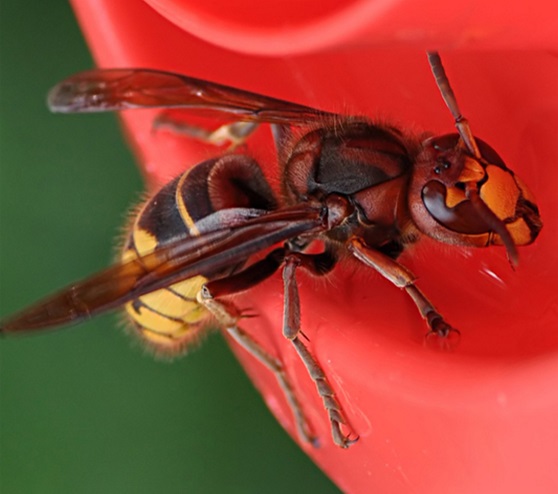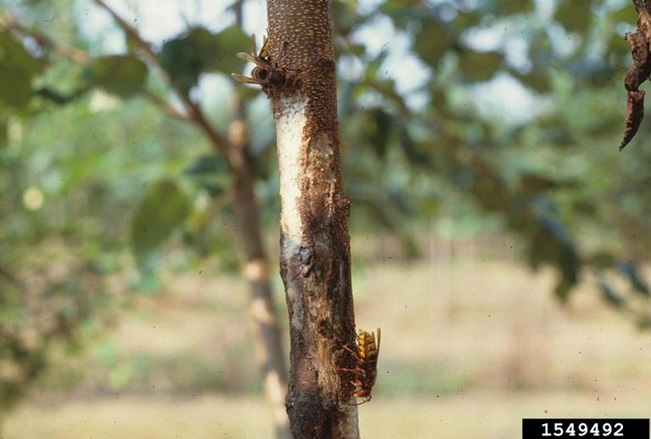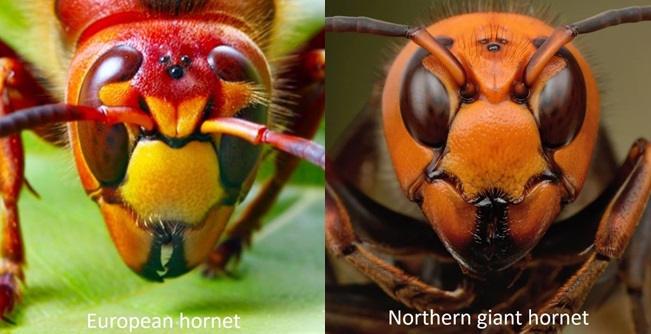European Hornet in Kentucky
ENTFACT-600: European Hornet in Kentucky | Download PDF
Jonathan L. Larson, Extension Entomologist
University of Kentucky College of Agriculture
Fast Facts
- European hornets are 1-1.5 inches long and are yellow, brown, and red with tinted wings.
- They most commonly nest in tree hollows but may also occasionally build in the soil or use wall voids in human-made structures.
- Queen hornets first appear around late April or early May in Kentucky at which point they will build their nest and begin rearing workers who take over many of the duties of the nest. She and all the workers will perish in the fall, only new queens she has produced will overwinter into the next year.
- Unless they are being a nuisance or if a nest is in an area where it poses a danger, it is best to leave European hornets alone. Nests near or in the home are best dealt with by professional pest control operator. There are homeowner options for aerosol products but be extremely cautious when using them.
Symptoms and Pest Description
Most people first notice the new queens of this species. They are large and active in the spring, sometimes even venturing into people’s homes in search of a suitable nesting site. By mid-summer, people may notice the workers in the landscape around their home or see a nest in a tree or other location outside.
European hornets may also create distinctive damage on trees and shrubs in the fall when they chew on branches and trunks to get to sap inside of the tree. Commonly used trees include lilac, rhododendron, and birch
European hornet workers are around an inch long, queens are larger at about 1.5 inches. The head and thorax are typically a dark red color with splashes of dark brown and yellow. The wings are tinted brown. waist. Adult sawflies are not often noticed in the landscape.

Figure 1: Adult European hornets have a yellow abdomen with dark brown patterns while the thorax and head tend to have a darker red color. (Photo by Jon Yuschock, Bugwood.org)
Life Cycle in Kentucky
European hornets have similar life cycles to other stinging insects like yellowjackets. In the spring, between late April and early May, new queens will emerge from hidden overwintering spots. They will seek out a suitable area, such as in a woodland, to start their nest. Most often, the queen will use a tree hollow where she will begin by constructing a small, teacup like paper nest. She will raise the first workers herself.
Once mature, the workers (all of whom are sterile females) will work on expanding the nest structure, foraging for food, and tending to the young. The queen will then solely lay eggs. As the season progresses, the nest will continue to expand. The structure on the outside will resemble a paper football that has been overfilled with air. On the inside, there are tiers of combs that contain the larval hornets. By July, new queens and some males will be produced, and they will mate. The original queen and all the workers will perish in the autumn, only the new queens that mated will overwinter into the next growing season.

Figure 2: A European hornet nest inside of a tree cavity. The papery material and the entrance hole are visible. Inside there are likely a few hundred hornets and the queen.
Potential Issues
European hornets are at their most defensive when their paper nest is threatened. That means that encountering an individual foraging away from the nest, it is not likely they will sting unless they are harassed or stepped on. While they prefer to use natural cavities in trees, sometimes the queen can construct her nest in a human-made structure. Nests have been found in attics and wall voids as well as in trees in yards. These situations can lead to people having unfortunate interactions with these insects.
A European hornet’s sting is painful but usually it is comparable in pain to other wasps and bees. One of the issues with hornet stings is that, unlike honey bees, these insects have a straight stinger, which means that each individual hornet can sting multiple times.
Hornets are predaceous insects for most of the summer. They have been known to kill honey bees but aren’t as associated with raids on hives as the Asian giant hornet. In the fall, European hornets may start to seek sugary foodstuffs. This can lead them to forage on fallen fruits, like apples, which people may be picking or harvesting. They will also strip bark from plants like lilacs or trees like birches, causing unsightly damage.

Figure 3: European hornets can cause girdling damage to shrubs and trees in the fall by stripping bark to get to sap underneath. (Photo by Jim Baker, North Carolina State University, Bugwood.org)
In addition to stings and damage, this species can cause alarm as they may be confused for the Northern giant hornet, also known as the “murder hornet”. European hornets have red on the tops and sides of their heads while Asian giant hornets tend to be more uniformly yellow orange. European hornets are also a half inch to an inch smaller than the Northern giant hornet. The Northern giant hornet has not been found in Kentucky; it is only known in the Pacific northwest in North America.

Figure 4: A comparison of the head of a European hornet and a Northern giant hornet. Northern giant hornets have uniform yellow-orange coloration while the European hornet has a red top and yellow front.
Management
While hornets are alarming to see, finding foraging workers does not necessarily mean you have a nest in or near your home. If you do locate a nest and it is somewhere out of reach of people or is in an out of the way area, it is best to simply leave it be. If the nest is in a problematic area outside or in the home, you should strongly consider having a pest control professional take care of the issue. They will have the proper equipment to do this safely. Getting up on a ladder and attempting to treat it with insecticides is dangerous on its own, adding in stinging pests just makes it more so.
If you must treat the nest yourself, you will have to be able to see the nest entrance. Treating the outside of the nest will not do anything and puncturing the nest can lead to hornets getting everywhere. Apply an aerosol “wasp and hornet” product into the nest entrance at night. This minimizes chances of active hornets. Also be sure to wear long sleeves, tuck the sleeves into gloves and long pants with the ends tucked into socks and shoes.
Revised 4/22
CAUTION! Pesticide recommendations in this publication are registered for use in Kentucky, USA ONLY! The use of some products may not be legal in your state or country. Please check with your local county agent or regulatory official before using any pesticide mentioned in this publication.
Of course, ALWAYS READ AND FOLLOW LABEL DIRECTIONS FOR SAFE USE OF ANY PESTICIDE!
Images: University of Kentucky Entomology unless otherwise indicated
